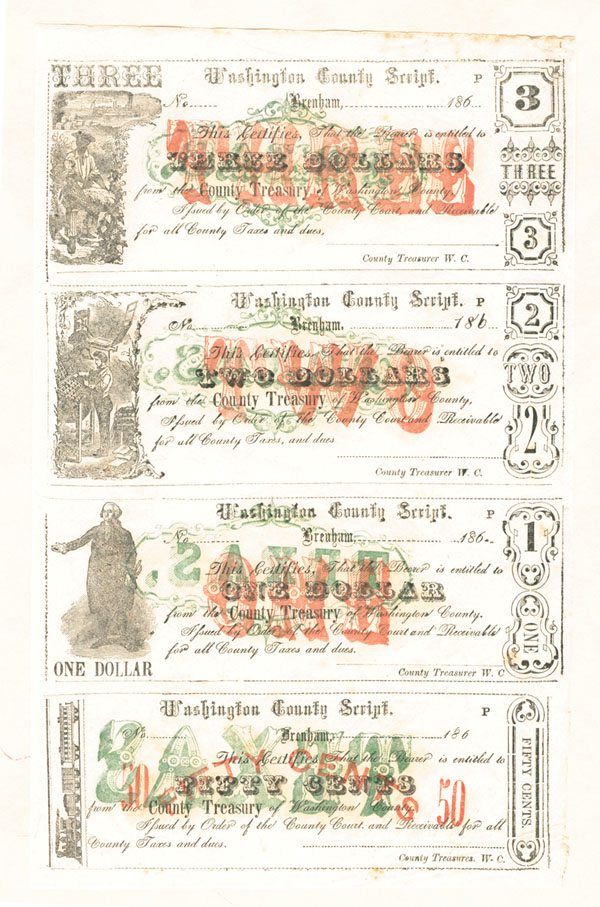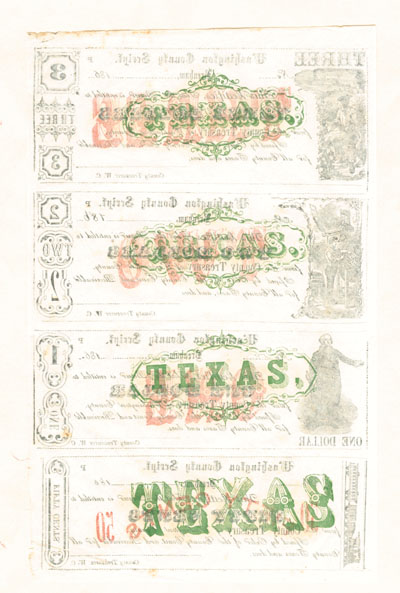Texas - Washington County Scrip Uncut Obsolete Sheet - Broken Bank Notes
Inv# OH1034

Washington County is a county in Texas. As of the 2020 census, the population was 35,805. Its county seat is Brenham, which is located along U.S. Highway 290, 72 miles northwest of Houston. The county was created in 1835 as a municipality of Mexico and organized as a county in 1837. It is named for George Washington, the first president of the United States.
Washington County comprises the Brenham, TX Micropolitan Statistical Area, which is also included in the Houston-The Woodlands, TX Metropolitan Statistical Area.
Washington-on-the-Brazos in the county is notable as the site of the signing of the Texas Declaration of Independence during the Convention of 1836. Reflecting the county's history as a destination of mid-19th-century German immigrants who came after the 1848 German revolutions, in the 2000 US Census, more than one third of residents identified as being of German ancestry.
Brenham (/ˈbrɛnəm/ BREH-nəm) is a city in east-central Texas in Washington County, United States, with a population of 17,369 according to the 2020 U.S. census. It is the county seat of Washington County.
Washington County is known as the "Birthplace of Texas," as it contains the site of the signing of the Texas Declaration of Independence on March 2, 1836 in the town of Washington-on-the-Brazos. This is now a state historic site.
Brenham is also known for its annual German heritage festival that takes place each May called Maifest, similar to Volksfest. Numerous German immigrants settled here in the mid-nineteenth century, following the Revolutions in German states in 1848. Brenham is also the Home of "The World's Largest BBQ Pit" on 290 West.
The area surrounding Brenham was occupied by various Native American tribes through the nineteenth century. The Brenham area was part of the Old Three Hundred, the first authorized colonization of Texas by Anglo-Americans led by Stephen F. Austin. In the 1820s and 1830s, several small communities developed in the area. In 1843, the Hickory Grove community was renamed Brenham in memory of a local physician, Richard Fox Brenham, who died while serving in the Texian militia during the Mier Expedition. On February 4, 1844, Washington County voters selected Brenham to become the county seat. German immigrants settled in Brenham as early as 1846. With the exception of the Civil War years, the German-born population of Brenham increased throughout the second half of the nineteenth century. The largest numbers of German immigrants arrived between 1880 and 1883. Jewish immigrants settled in Brenham beginning in the 1860s and established one of the first Orthodox congregations in Texas in 1885.A banknote—also called a bill (North American English), paper money, or simply a note—is a type of negotiable promissory note, made by a bank or other licensed authority, payable to the bearer on demand. Banknotes were originally issued by commercial banks, which were legally required to redeem the notes for legal tender (usually gold or silver coin) when presented to the chief cashier of the originating bank. These commercial banknotes only traded at face value in the market served by the issuing bank. Commercial banknotes have primarily been replaced by national banknotes issued by central banks or monetary authorities. National banknotes are often – but not always – legal tender, meaning that courts of law are required to recognize them as satisfactory payment of money debts. Historically, banks sought to ensure that they could always pay customers in coins when they presented banknotes for payment. This practice of "backing" notes with something of substance is the basis for the history of central banks backing their currencies in gold or silver. Today, most national currencies have no backing in precious metals or commodities and have value only by fiat. With the exception of non-circulating high-value or precious metal issues, coins are used for lower valued monetary units, while banknotes are used for higher values. Code of Hammurabi Law 100 (c. 1755–1750 BC) stipulated repayment of a loan by a debtor to a creditor on a schedule with a maturity date specified in written contractual terms. Law 122 stipulated that a depositor of gold, silver, or other chattel/movable property for safekeeping must present all articles and a signed contract of bailment to a notary before depositing the articles with a banker, and Law 123 stipulated that a banker was discharged of any liability from a contract of bailment if the notary denied the existence of the contract. Law 124 stipulated that a depositor with a notarized contract of bailment was entitled to redeem the entire value of their deposit, and Law 125 stipulated that a banker was liable for replacement of deposits stolen while in their possession. In China during the Han dynasty, promissory notes appeared in 118 BC and were made of leather. Rome may have used a durable lightweight substance as promissory notes in 57 AD which have been found in London. However, Carthage was purported to have issued bank notes on parchment or leather before 146 BC. Hence Carthage may be the oldest user of lightweight promissory notes. The first known banknote was first developed in China during the Tang and Song dynasties, starting in the 7th century. Its roots were in merchant receipts of deposit during the Tang dynasty (618–907), as merchants and wholesalers desired to avoid the heavy bulk of copper coinage in large commercial transactions. During the Yuan dynasty (1271–1368), banknotes were adopted by the Mongol Empire. In Europe, the concept of banknotes was first introduced during the 13th century by travelers such as Marco Polo, with European banknotes appearing in 1661 in Sweden. Counterfeiting, the forgery of banknotes, is an inherent challenge in issuing currency. It is countered by anticounterfeiting measures in the printing of banknotes. Fighting the counterfeiting of banknotes and cheques has been a principal driver of security printing methods development in recent centuries.










Ebay ID: labarre_galleries